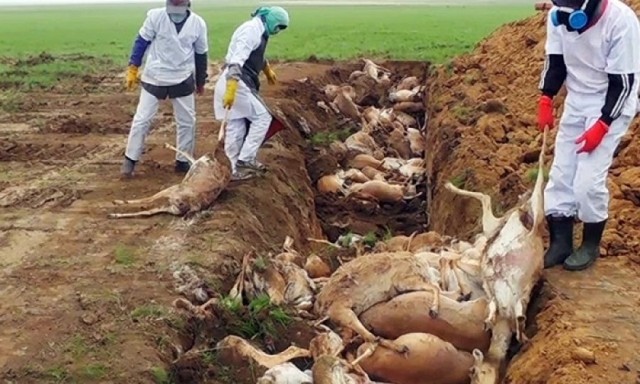An entire herd of of saiga, which is a certain kind of antelope that is indigenous to Kazakhstan, has mysteriously died, wiping out 60,000 of the animals in four days. The die-offs started last May as veterinarians and conservationists try to pinpoint the cause as similar herd crashes occurred across the country where this mass dying ended in June.
Researchers are now carrying out investigations to solve how half of the country's herd, around 257,000 of them as of 2014, died in a matter of a couple of months. According to geoecologist Steffen Zuther from the Altyn Dala Conservation Initiative, a bacteria is responsible for this unprecedented die off however, it is still a mystery as how a harmless strain of bacteria could cause so much devastation to an animal population.
Zuther says that the extent and speed of this saiga die off throughout the entire calving herd, killing all of them, has not been seen in any other animal species.
Saigas have a pivotal role when it comes to the grassland steppe ecosystem in Kazakhstan, as they help break down organic matter when fallen plant material slowly decompose during the winter. The saigas graze on this organic material which then recycles nutrients and even prevent wildfires that is caused by too much dead leaves on the ground.
However, saigas are also listed as a critically endangered species by the International Union for the Conservation of Nature where there are only a few herds in Kazakhstan and one in Russia and Mongolia. During cold winters, the herds huddle together and migrate to other regions of Kazkhstan then the herds split up to calve their young during late spring to early summer. However, this die-off occurred during a calving period.
In the recent years, these die-offs have become a frequent phenomenon where one last year killed 12,000 of the saigas. However, the terrain and geography of the country made it difficult for help to arrive as vets and researchers could not get to the animals in time due to the expanse of the steppe region.
With this delay, scientists eventually determined that the abundant greenery caused some digestion problems that encouraged bacteria overgrowth inside the saiga guts.
This time around, when field workers were already on the site, they were able to obtain some specimens from the saiga environment including rocks and soil where they were dwelling. Apart from these, researchers also collected water samples and vegetation that the saigas drank and fed upon, just before this die off began. They also gathered insects and ticks from the animals to find more clues.
After conducting necropsies of the animal bodies, researchers also observed saiga behavior as they were dying. Female antelopes that cluster together and calve their young were the hardest hit by this die off where they died first followed by their young. Zuther concludes that whatever was killing the animals is now being transmitted via mother's milk.
Researchers revealed that the toxins were produced by Pasteurella and probably the Clostridia bacteria that affected the animals' organs, bleeding profusely. However, Pasteurella is apparently commonly found in saigas that is also basically harmless to them unless they possess weaker immune systems.
Scientists now conclude that the saigas' massive death toll was caused by a garden variety bacteria but this genetic analysis can only reveal more clues as how this bacteria evolved into a plague. Zuther says, there is nothing special about it but why it spread so rapidly and killed so many animals is still a mystery.



























